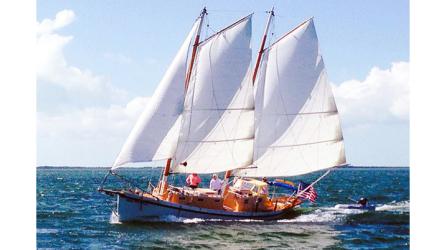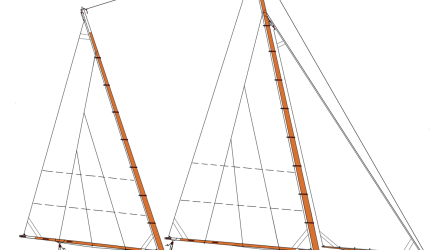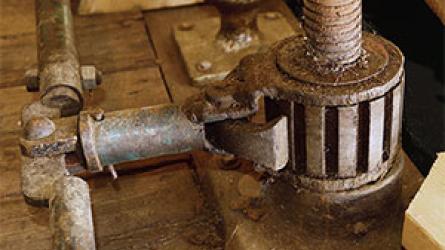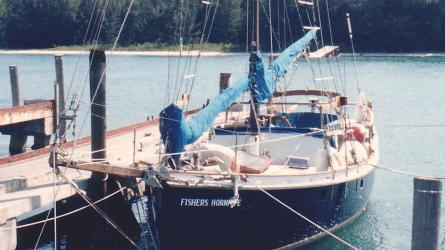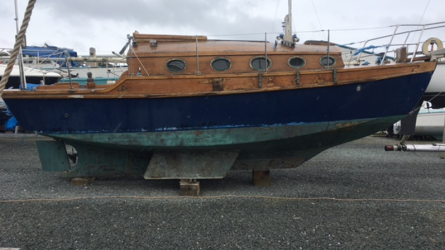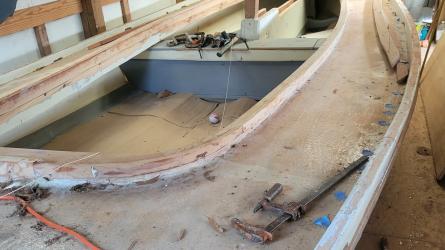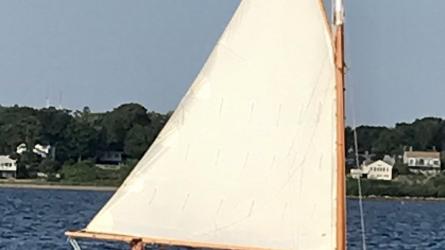From Lobsterboat to Lobster Yacht
The transformations of two Bunker and Ellis lobsterboats
The transformations of two Bunker and Ellis lobsterboats
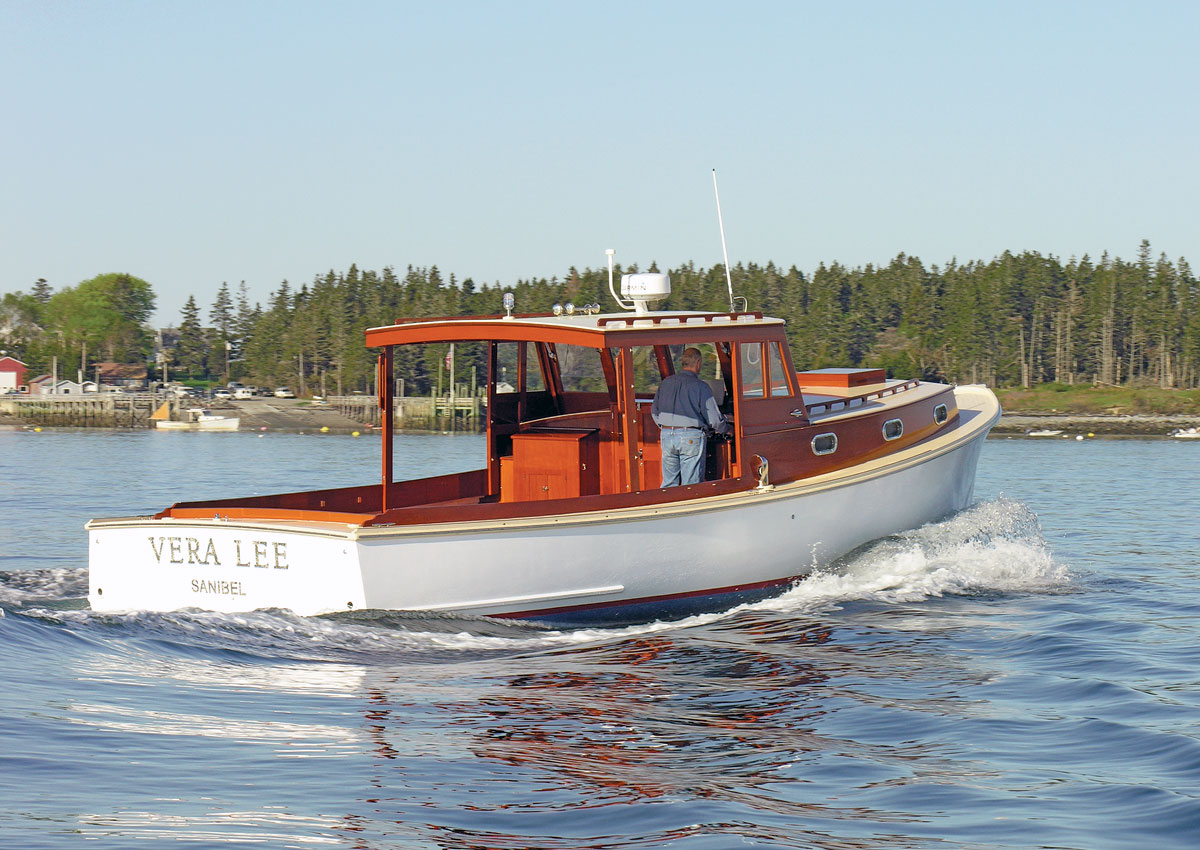
MATTHEW P. MURPHY
VERA LEE—née FANCY STUFF—is one of a handful of Bunker and Ellis–built wide-body lobsterboats. She was transformed into a luxury powerboat. Built in 1974, FANCY STUFF was restored and re-outfitted by Jarvis Newman and Ed Gray at their boatshop on Great Cranberry Island, Maine. VERA LEE was relaunched in 2008.
FANCY STUFF, a 36′ Bunker and Ellis lobsterboat, arrived at the Newman and Gray Boatyard on Great Cranberry Island, Maine, in March 2007 after a short run up the coast from her former home on the nearby island of Vinalhaven. With three decades of fishing under her belt, she set a rough and weather-beaten figure on her new mooring. She was well past her prime, but her fine lines and rich heritage convinced builders Jarvis Newman (son-in-law of Raymond Bunker, one of her builders) and my family friends Ed and Josh Gray to give her a new beginning.
Raymond Bunker and Ralph Ellis built FANCY STUFF, and her sistership PINE KNOT, in their Southwest Harbor boatyard in 1974. The sisters were two of five wide-body lobsterboats produced by Bunker and Ellis near the end of their 58-boat career. Both boats were sold to Vinalhaven lobstermen, and were moored and fished off that island until their respective sales to Newman and Gray Boatyard in 2003 (PINE KNOT) and 2007 (FANCY STUFF). These boats, each with a 12′6″ beam, were a full 1′6″ wider than the builders’ other 36′ models. The move toward ever-beamier boats was driven by improvements in engine technology and the trend in the lobster fishery toward using more gear farther offshore.
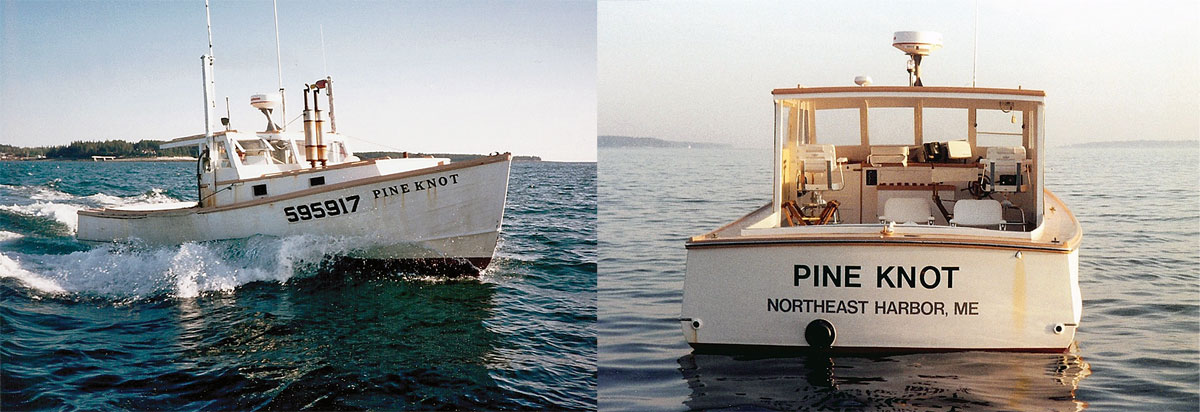
JARVIS NEWMAN (Both)
Above left—PINE KNOT was the first Bunker and Ellis lobsterboat to make her way to the Newman and Gray boatyard after a long career as lobsterman Warren “Tung” Young’s workboat. Above right—PINE KNOT, now a day boat moored in Northeast Harbor, shows off her 12′6″ beam, which adds to her stability and comfort underway. The wide-body design combines all the stalwart features of a workboat with the comforts desired in a fine yacht.
Boatbuilders east of Mount Desert Island generally produced skeg-built or Jonesport-style boats, in contrast with “built-down” boats. Skeg boats have the skeg attached to the outside of the hull, while built-down boats incorporate the skeg as part of their hull, rather than as an appendage. Skeg boats are easier to build and, with less hull volume, tend to be slightly faster. However, built-down boats are known for their better seakeeping ability and their cargo capacity.
Newman, with a soft spot for his father-in-law’s boats, had taken a fiberglass mold off of the 36' Bunker and Ellis lobsterboat IRONA in 1971 and produced 89 hulls from it to be used as both lobsterboats and pleasure boats. Newman and Gray opened their own boatyard in 1991, after Newman bought a run-down boatbuilding shop on Great Cranberry Island. “I was walking down the beach one day and there was Jarvis jacking up the corner of that old building with a little hand jack. We got to talking and at the end of our conversation we shook hands, and that was the start of our boat business,” Gray said. Since then, the yard has specialized in custom wooden and fiberglass rebuilds of Downeast-style lobster yachts.
PINE KNOT was the first of the Bunker and Ellis sisterships purchased by Newman and Gray in September 2003 after her owner, Vinalhaven lobsterman Warren “Tung” Young, passed away. “I got thinking, if anybody was looking for an old Bunker boat, it’d be Jarvis,” said Tung’s son, Wayne Young. Tung’s widow, Mary Ann, and Wayne contacted Newman and arranged PINE KNOT’s sale in 2003, a move that would eventually lead her sistership, FANCY STUFF, to the Newman and Gray yard in 2007. “She was green, slimy, ugly, dirty. I didn’t think we’d ever get that thing clean,” said Bart Smith, who bought FANCY STUFF from Newman and Gray that same year.
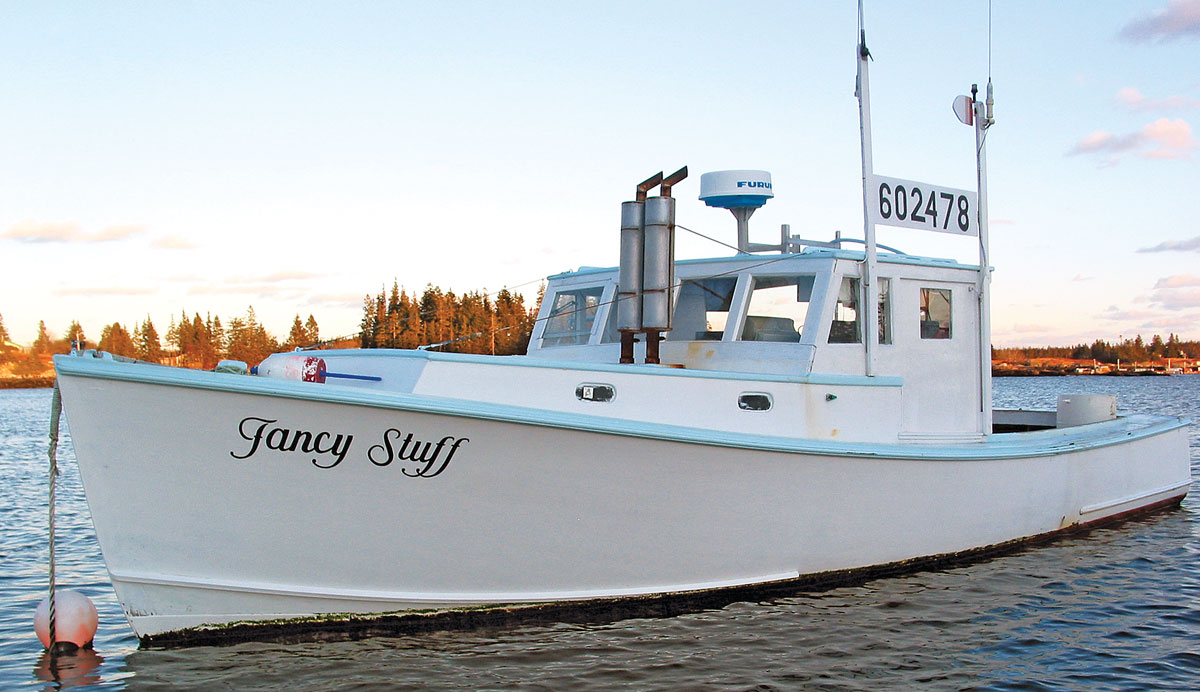
COLLECTION OF ED GRAY
Bunker and Ellis departed from their contemporaries who, at that time, tended to build skeg boats. FANCY STUFF’s semi-displacement, built-down hull gave her excellent stability and carrying capability. She was also given a high bow to take offshore waves and a low stern for hauling and stacking traps, creating an eye-catching and functional profile.
FANCY STUFF’s dual dry-exhaust stacks fed up through the top of her trunk cabin in front of her windshield. Her 6-71 Detroit Diesel engine occupied almost her entire interior cabin space. The cabin sides, beams, and top were rotted, and exhaust from her engine had left her interior black. Her cramped V-berth was stacked with spare parts all coated in diesel soot, and it was clear from the stench hanging in the air that bait had been coating her bilge for more than 30 years.
Clearly, FANCY STUFF was made for lobstering. Bunker and Ellis placed a premium on deck space, providing adequate room for a starboard-side pot hauler, a sorting table, and for carrying stacks of traps at the stern.
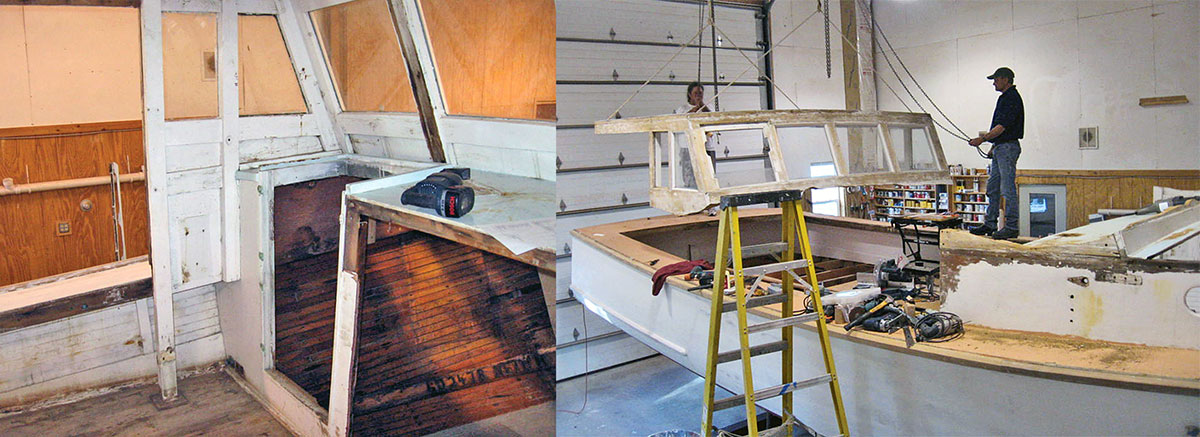
ED GRAY COLLECTION (BOTH)
Above left—By the time FANCY STUFF arrived at the Newman and Gray Boatyard, she was showing her age; her interior worn and rotted, she would be gutted for a total refit. Her offset companionway would be removed and relocated to center. Above right—The weathered standing shelter was hoisted and replaced with a mahogany shelter that would be varnished. Bulkheads and part of her cabintop would be replaced later on, left intact through most of the reconstruction to help her retain her shape.
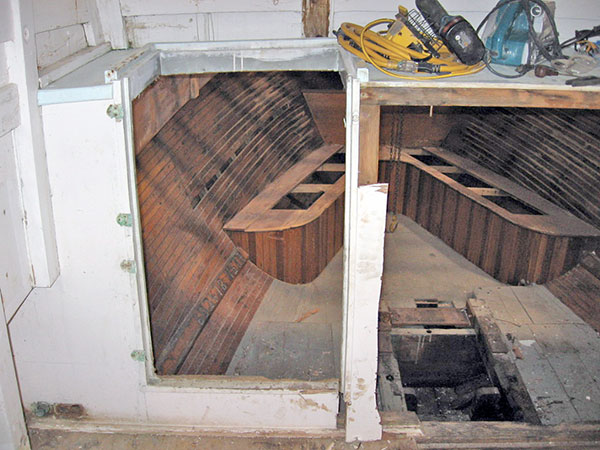
ED GRAY COLLECTION
A parting look at her old interior with its fisherman’s berth after her engine, hydraulic tank, and hosing for her pot hauler were removed.
Radiating Downeast authenticity, it’s no wonder she was featured in the 2006 independent film Islander, in which rebel lobsterman Eben Cole (played by Thomas Hildreth) declares war when another lobsterman invades his territory. The two pink hearts floating above the name FANCY STUFF painted across her transom stood in stark contrast to her rough-and-ready image. Still evident, however, was the Bunker and Ellis charm that Smith was after. “I had always wanted a Downeast boat,” said Smith. “I wanted something with a little history to it.” With both history and celebrity, FANCY STUFF seemed just right for Smith. “I took the ferry out to Cranberry, and there was this awful, ugly thing…. We crawled all over that boat—‘the bones were good,’ as they say,” declared Smith.
Smith had waited more than a decade to be in a financial position to rebuild a Bunker and Ellis lobsterboat, and with a limited number of the wide-body style boats available, he felt this opportunity was too good to miss. He had read about FANCY STUFF’s renowned builders at the nearby Great Harbor Maritime Museum in Northeast Harbor and had spoken with several friends and fishermen on the subject. “I got the impression that if you were buying a car, you could buy a Chevrolet, a Bentley, or a Rolls Royce. Bunker and Ellis produced something like a Bentley. What they built was regarded as a fine, traditional, well-built boat,” said Smith. Although, Smith admitted, it was difficult to see FANCY STUFF’s potential at his first inspection, Gray walked Smith over the boat and talked out her possibilities.
“He [Smith] had a lot of faith in us,” said Gray. “He had seen our other custom jobs and had faith in what he was getting…. He gave us his priorities and left the finish work up to the yard.”
Newman and Gray refurbished PINE KNOT in the winter of 2003–04. With no immediate sale pending, Gray had begun speculation work by moving her engine bed back 3′ and repowering the boat with a wet-exhaust 300-hp John Deere. He then replaced her trunk cabintop, windshield, and coamings, and gave her a thorough scraping and painting.
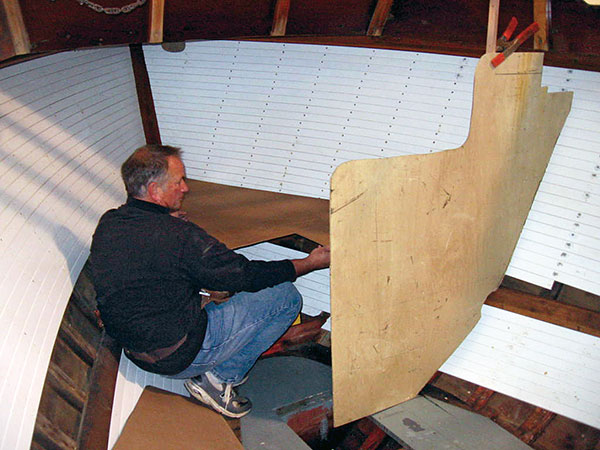
ED GRAY COLLECTION
Ed Gray fits patterns for new forward compartments and V-berths.
PINE KNOT was sold to Nick Vanoff in June 2004. “I had looked for a day boat for a long time. I knew everything that was available up and down the coast,” said Vanoff. “It’s a comfortable boat. It’s timeless.” Attracted to her workboat heritage, Vanoff kept the name, PINE KNOT, and had little desire to change much else, believing that “the boat wasn’t built to have accommodations.” The new owners’ contrasting views created a fork in the sisterships’ path. “I didn’t want a workboat,” Smith said, “I was done working. I wanted a cruising boat.” The sisters parted ways as Vanoff moved PINE KNOT to the nearby Abel’s Boatyard, on Mount Desert, while Smith and FANCY STUFF stayed put at Newman and Gray.
Smith told Gray he wanted to run FANCY STUFF to Nova Scotia, Block Island, and Long Island Sound. He hoped one day to cruise the Great Loop, the approximately 5,000-mile circumnavigation of eastern North America. “We had the basis to build something…but, we wanted to create a practical cruising machine,” said Smith. He wanted Gray to maintain the boat’s classic lines while striking a balance between deck space and interior accommodations: to create a lobster yacht instead of a lobsterboat. The proven workboat heritage of FANCY STUFF’s semi-displacement hull had benefits for a cruising man like Smith: speed in the 15-knot range, a full keel for rudder and propeller protection, and a fine entry for easily cutting through seas. But creating a yacht out of a workboat implied entirely transforming her layout and bare-bones finish to the opulent comfort of a cruiser. Where the Detroit Diesel formerly sat, Smith asked for a Herreshoff-style interior with three berths, a head with shower, air-conditioning, and a full galley, which would require that her main bulkhead and pilothouse be moved more than 5′ aft. Gray also needed to add almost 8" to the cabin’s 5′6″ headroom, which he accomplished partly by giving the cabintops more camber and partly by lowering the cabin sole. Although this meant cutting the floor timbers, Gray felt that the Bunker and Ellis wide-body boats were built so heavily (2″ oak floor timbers on 18½″ centers) that shaving them down slightly would not weaken the boat. Rebuilding in this manner would add interior height while maintaining, as closely as possible, the traditional lobsterboat’s low silhouette.
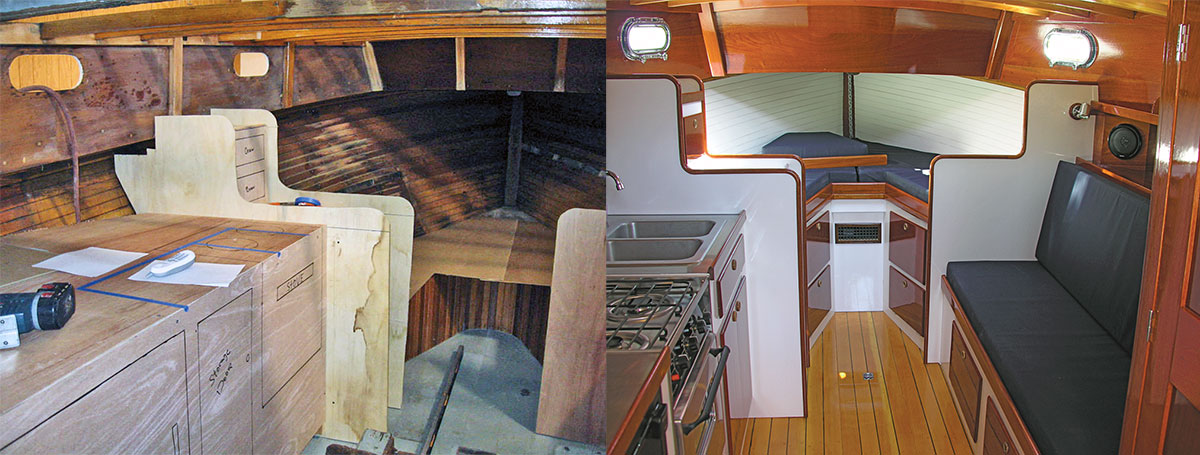
ED GRAY COLLECTION (Left) MATTHEW P. MURPHY (Right)
Above left—With the owner’s permission Gray created an interior mock-up in ¼" plywood, which helped in achieving the best configuration for the galley and adjacent stowage. Above right—The clean, Herrshoff-style interior is painted and dressed with bright fiddles and trim.
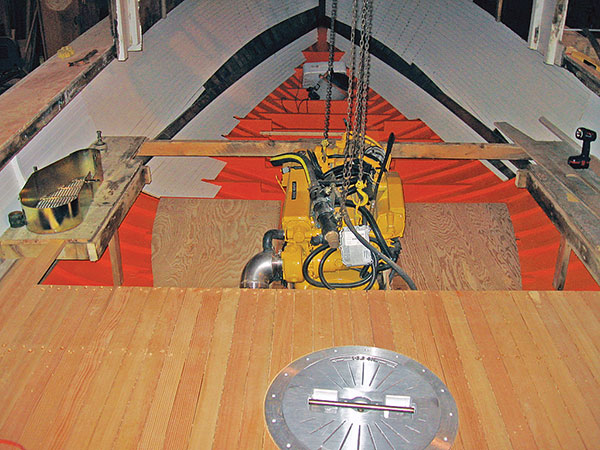
ED GRAY COLLECTION
A new 300-hp wet-exhaust John Deere diesel is lowered onto its new white oak beds.
Smith wanted to repower FANCY STUFF with a 300-hp, wet-exhaust John Deere diesel engine driving a 2:1 reduction gear. Horsepower was limited by propeller size, which in turn was limited by the fixed opening of the propeller aperture designed for the smaller engines available the year she was built. Her new engine required new oak engine beds, and her new layout called for them to be installed aft of the originals. In order to make her float on her lines, the weight of the aft-shifted engine would be balanced by the added weight of the joinery and systems forward. “The hardest part,” said Gray, “was getting that engine and muffler in there low enough to maintain a good angle on the exhaust.” It was tough getting the engine low enough to minimize the height of the raised platform above it, yet not have it (and/or the muffler) so low as to flood through the exhaust pipe. Gray also planned to install tanks in her stern to feed Smith’s long-distance cruising plans. He would replace the 100-gallon tanks under the platform with two 60-gallon tanks under the after deck. He also intended to add freshwater and blackwater tanks and a hot-water heater under the platform just aft of the main bulkhead.
In August 2007, FANCY STUFF was hauled for the first time—save for short periods ashore for maintenance—since she had been built. Gray began work with a five-person crew, including his son Josh who is now a partner in the yard. They removed the pot hauler, stripped the nailed-on fiberglass sheathing from her starboard side and bow, cut off her shelter, removed her cockpit platform, and stripped away the copper keel-cooler pipes. Then Gray began the one-year refit, first by filling the holes in her cedar planking and then fairing the dings and dents in the hull and deck. Luckily, the sheathing had protected the hull against trap-hauling chafe well enough that he could retain all the original planking.
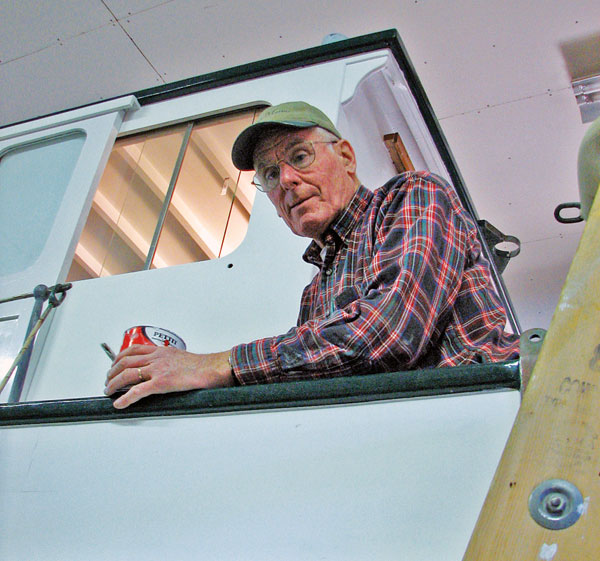
LAUREN SIIMMONS
Jarvis Newman, Raymond Bunker’s son-in-law, has developed molds for a variety of Downeast-style hulls in fiberglass that are based, both directly and indirectly, on Bunker and Ellis boats.
With Smith’s approval, Gray created a ¼″ plywood mock-up of the interior to give Smith a three-dimensional sense of the modifications he desired. Along the now-centered companionway, Gray laid out what would later be a full galley to port with sink, propane stove, and refrigerator. To starboard, he mocked up a head and shower followed by a settee convertible to a berth. Forward of the galley to port would be a set of drawers and in the bow, a V-berth with storage underneath. All the original wiring, electronics, and paneling were removed. With long-distance cruising in mind, Smith chose to have an integrated chart plotter and radar. He also installed air-conditioning for navigating in warmer climes.
On deck, Gray maintained the lobsterboat cockpit and open cabin sides. The spacious deck would now serve passengers enjoying fair-weather cruises and weekend picnics instead of being used for harvesting lobsters. Gray did extend the cabin sides beyond the main bulkhead for partial weather protection. By doing this, he maintained the open sides, providing good visibility during docking while also allowing the helmsman to duck out of the elements.
In rebuilding the exterior, Gray maintained the same windshield rake but added some height to accommodate the relocated engine, which would now be aft of the bulkhead and under a raised portion of the platform. He also reshaped the windows in the windshield to match the crown of the cabintop. Forward of this, on the cabintop, Gray added a hatch for ventilation, and installed three stainless-steel opening ports on each side.
Smith wanted to keep a spartan deck layout to mimic FANCY STUFF’s clean, traditional profile. He avoided installing a bow pulpit. Instead, he mounted a Danforth anchor on the foredeck, as her previous owner had done, and added an electric windlass that can be operated from the helm station as well as from the foredeck.
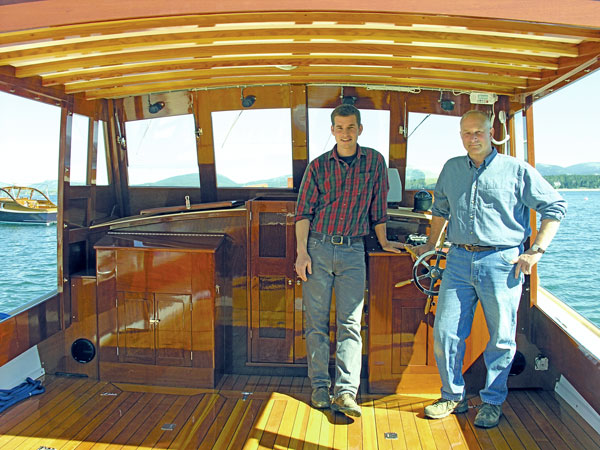
MATTHEW P. MURPHY
Josh Gray (left) and his father, Ed (right), along with Jarvis Newman, carry on the legacy of Bunker and Ellis. VERA LEE maintains her workboat roots while providing all the amenities and aesthetics of a fine yacht.
Although at first he had planned on keeping her original name, Smith decided to rename FANCY STUFF, rechristening her VERA LEE in honor of his mother, who had recently passed away without ever having seen the boat. Gray launched VERA LEE in July 2008 and ran sea trials shortly afterward.
“Ed really did a remarkable job of maintaining the lines. People know it’s a Bunker and Ellis boat,” said Smith, who used VERA LEE around Mount Desert Island waters that summer.
“All in all, she performed and handled really well,” said Gray. She was back in salt water and, while retired from fishing and outfitted with amenities that are in stark contrast to her original purpose, she was restored to a quality and aesthetic consistent with her Bunker and Ellis heritage.
“We ride out of Southwest Harbor, and we have people stand up in their cockpits and give us the thumbs-up. It’s a beautiful boat, and of course it’s an antique. To me, it’s a piece of art structured in a fashion that we can enjoy,” said Smith. “I’m so proud of that boat. I just want to show it off.” 
Lauren Simmons is a freelance writer who lives in Bass Harbor, Maine. She graduated from Colby College in 2006.
Bunker and Ellis
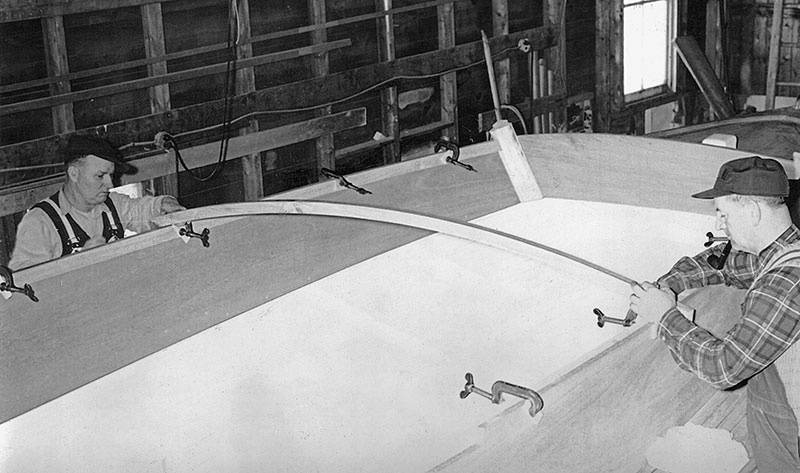
GREAT HARBOR MARITIME MUSEUM COLLECTION
Ralph Ellis (left) and Raymond Bunker built 58 boats in their small boat shop.
Raymond Bunker and Ralph Ellis joined forces in 1945. Raymond Bunker, born on Great Cranberry Island, got started in the boat business at approximately the same time as the end of the Second World War. He became the foreman at Southwest Boat as that yard expanded production to supply equipment for the Navy. There, renowned builder and designer Chester Clement mentored Bunker, and Clement’s influences can be seen in many of Raymond Bunker’s designs. Ralph Ellis was a boat captain, a fisherman, and a house and boat carpenter. The two men were ripe for change in 1945 when one evening, over a game of pool in Southwest Harbor, they decided to strike out on their own in Ralph’s Manset-based shop.
What began as late-night and weekend work gained momentum into a full-time business as Bunker and Ellis powerboats caught on. Bunker and Ellis produced a total of 58 boats for both work and pleasure, beginning with the 32′6″ boats EVENING PASTIME and RICHARD D in 1946, and ending with the 37′4″ SISTER’S PRIDE in 1978. Their boats ranged from 22′ to 44′ in length.
They produced a record five boats in 1955, but typically built only two to three boats per year, all characterized by fine workmanship. Their shop was so small that they could only build one boat at a time, although they would usually mill wood for two boats at a time and set the second boat’s materials off to the side while they set up the keel and steamed the timbers of the first boat. For a two-man operation they built at a remarkable pace while still maintaining careful attention to both aesthetics and quality. Their personalities complemented each other, and they got along without a hitch during their 32 years in business together.
Perhaps the pair’s best-known boat is the 42′ JERICHO, built for Thomas S. Gates, Jr., President Eisenhower’s secretary of defense. JERICHO has the lines of a traditional lobsterboat, with all the amenities of a lobster yacht. After she was launched in 1956, Raymond Bunker served as JERICHO’s skipper for the next 24 summers.
While running JERICHO out of Northeast Harbor’s Clifton Dock, Raymond Bunker was able to promote Bunker and Ellis boats to wealthy summer residents. Bunker and Ellis were early to play on the idea of using a workboat design with its proven performance and handling at sea, and applying it for the benefit of the yachtsman. Today Bunker and Ellis boats are especially sought after for their style, prestige, and longevity. Their exceptional craftsmanship and heavy build have served them well over time: A number of them have been restored, while others, through consistent care, have lasted without needing a major restoration.
Raymond Bunker retired from boatbuilding and yachting during the 1980s. Ralph Ellis went on to design and build fiberglass boats with the Lee Wilbur Company before starting Ellis Boat Company, now run by his son, Don Ellis. Raymond Bunker and Ralph Ellis both died in 1994. —LS
